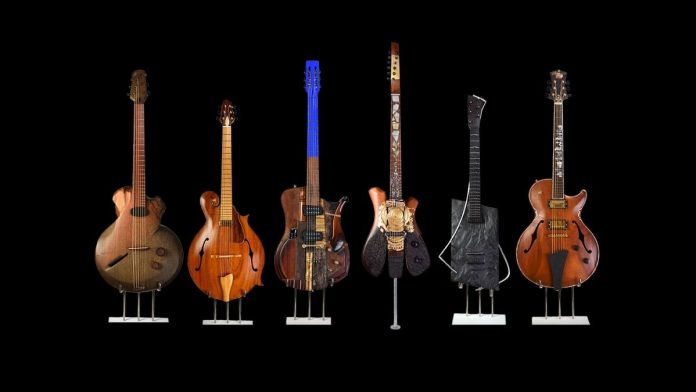The Guitar Barrel Project, also known as Guitars of the Marquis, originates from the discovery of mahogany barrels believed to have belonged to the wine cellar of the Marquis of Pombal in eighteenth-century Oeiras. This discovery by Portuguese luthier Adriano Sérgio set the foundation for crafting six unique guitars that will never be replicated, honouring the rich history of this precious wood. Inspired by the earthquake that devastated Lisbon on All Saints’ Day in 1755 – a disaster that ushered in the Age of Enlightenment, a time marked by the triumph of scientific thought and political revolutions – these exceptional instruments were unveiled on 14 May 2023 in the cellar of the Marquis of Pombal’s Palace. The project brought together master luthiers from Europe: Nik Huber (Germany), Andy Manson (United Kingdom), Claudia and Claudio Pagelli (Switzerland), Michael and Tania Spalt (Austria), Ulrich Teuffel (Germany), with Adriano Sérgio representing Portugal.
Discovery, Collaboration, and the Legacy of Historic Mahogany Wood
Adriano Sérgio stumbled upon the wood by pure chance. He had no idea the barrels could be made of mahogany, a wood with origins spanning from South America to Brazil and Africa. Given that the Marquis of Pombal’s brother dealt in timber, the provenance made sense. With limited funds, Adriano partnered with Ulrich Teuffel to buy approximately six tonnes of this special timber. He spoke to fellow luthiers Claudio Pagelli, Nik Huber, Michael Spalt, and Ulrich Teuffel at a Milan fair and proposed collaborating on a project using this rare wood.
Ulrich’s deep knowledge of the Enlightenment, an era shaped by the 1755 Lisbon earthquake that famously challenged the Church, added context. At that time, Germany aided Lisbon by sending wood; Portugal enjoyed wealthy ties with England, and the Marquis served as ambassador in Austria. Considering the global scale and impact, the idea was for each luthier to build a guitar in secret, with the theme focused on Lisbon during the earthquake.
The man who sold Adriano the wood recalled that his great-grandfather said the timber came from the Marquis of Pombal’s estate. When this became public knowledge, Oeiras took an interest, restored one barrel purchased back from the project, and aged wine in it to rediscover how it tasted historically. The 1755 earthquake changed everything: those who sought refuge in churches perished, while people in brothels and gambling houses survived. This shattered people’s belief in divine punishment, arguably shaping the courage behind cultural revolutions like rock’n’roll.
Handling timber over 250 years old posed challenges. None treated it as ordinary wood. Each luthier brought unique ideas and emotions, united by responsibility.
Claudio and Claudia Pagelli

Claudio and Claudia Pagelli were the first to share their thoughts on their one-of-a-kind creation. Claudio explained that their aim was not to make a conventional guitar but to preserve the original form of the selected wood, respecting its story and uniqueness. Their design reveals marks left by the cleaning of the barrel, a task so demanding it required a child to enter through its tiny opening to perform manual maintenance. The guitar’s front evokes the tumultuous waves of the tsunami that struck Lisbon, with the fire that consumed the city immortalised along the ebony fretboard. The undulating metal bars were meticulously affixed to grant the guitar full playability, while the tuning pegs were designed following eighteenth-century violin-making criteria. The most impressive feature of this atypical guitar, however, lies in its frets, which employ the “True Temperament” method, a technique using wavy shapes to achieve perfect intonation.
Nik Huber
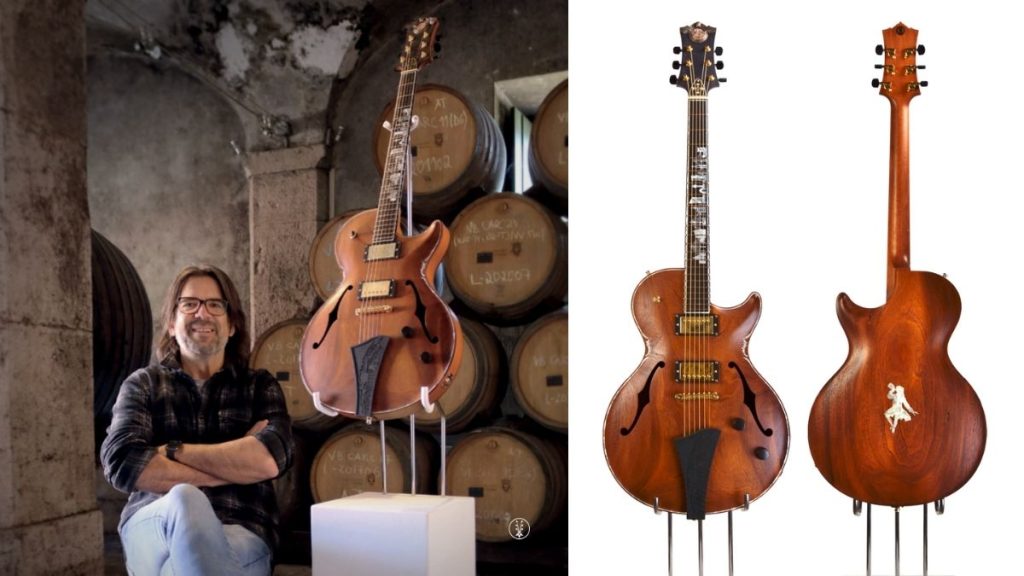
Nik Huber’s semi-acoustic model, though the most traditional in shape among the six, remains packed with significant details. Remaining faithful to his style, all decorative elements on the guitar draw inspiration from the ornamental features of the Marquis of Pombal’s Palace. The back sports a mother-of-pearl inlay of a figure drinking, similar to imagery found within the palace. While the guitar’s body pays homage to a bygone Lisbon, its fretboard presents representations of key contemporary Lisbon buildings, establishing a connection between two distinct eras.
Adriano Sérgio
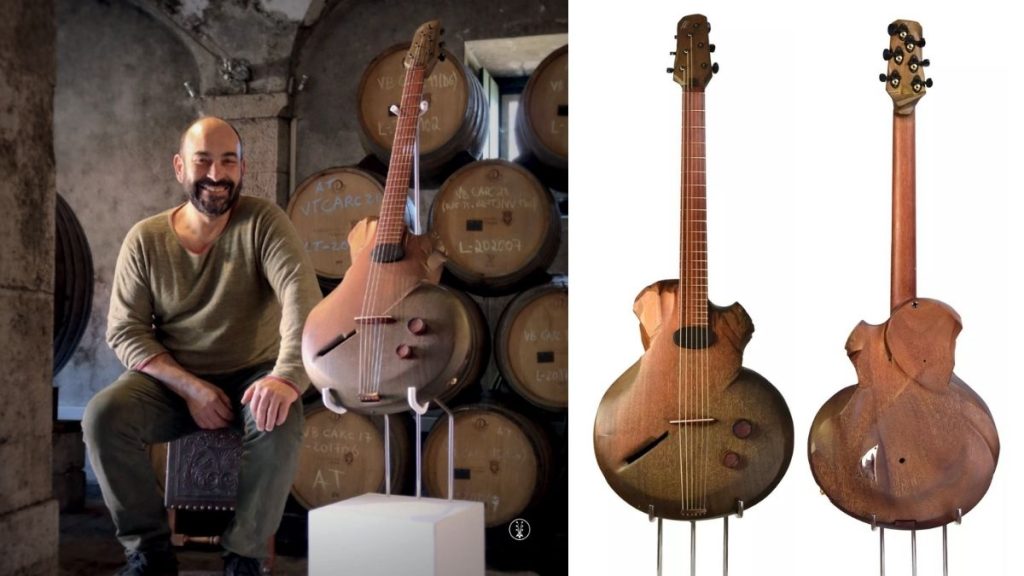
In keeping with his visual identity, Adriano Sérgio designed his guitar precisely on the anniversary of the tragic event, limiting himself to the 18 minutes that the catastrophe lasted. Inspired by the Portuguese guitar, the design divides the upper and lower halves with a tectonic fault line, projecting the colours of ocean, earth, and fire. The instrument’s upper half depicts a ruined Lisbon, while the neck and headstock reflect the zones of prostitution and gambling that survived the disaster. An inverted cross symbolises the questioning of the Church and divinity that followed the 1755 earthquake. The bridge resembles a detailed miniature Portuguese caravel, and the control knobs reference the barrels. On the back, the infinity symbol, used by the Marquis and his brothers, is visible. The mahogany neck features a Pau Rosa fretboard, likely African in origin, discovered serendipitously.
Ulrich Teuffel
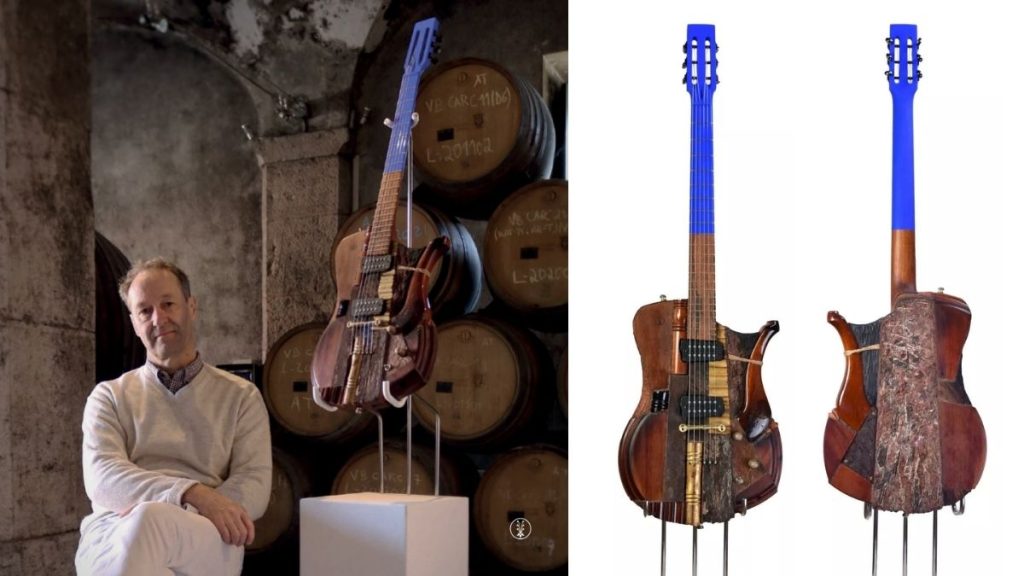
There is an obvious link between the wine barrel, restored by the Oeiras City Council and displayed alongside the guitars, and the creation by German luthier Ulrich Teuffel. Departing from his usual machine-based methods, Teuffel employed hand tools and wood pieces he found wandering Lisbon after the 1755 earthquake. The way he glued the pieces followed a historic recipe combining wood dust, ash, and other elements used for healing. He built a small furnace to melt the barrel brass, which he then used to craft the bridge, knobs, and pickup selector tip. The headstock and upper neck were painted blue, a rare and expensive eighteenth-century colour, intentionally left unprotected so use would gradually fade it.
Andy Manson
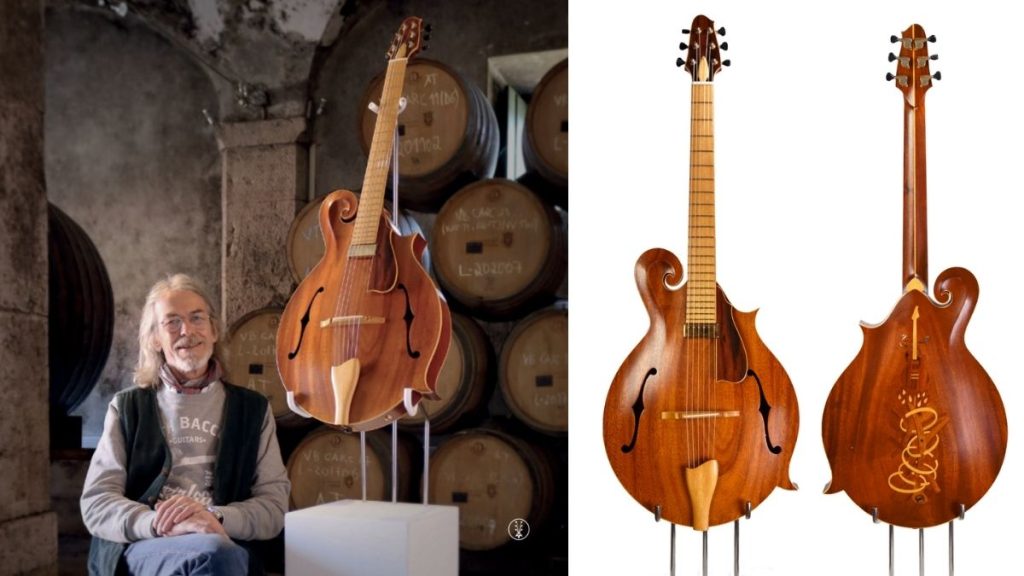
English luthier Andy Manson, based in Portugal, committed to creating a functional semi-acoustic guitar capable of quality musical output without losing his creative impulse, heavily inspired by the baroque style and the architectural details of the palace. The top-left symbolises the tsunami, while the back depicts a barrel’s explosion, which, like the phoenix, gives rise to modern ideas such as the electric guitar. Manson described the wood as having a magical nature.
Michael and Tania Spalt

Michael and Tania Spalt explained the symbolism behind their electric guitar design. Fascinated by the catastrophe’s historical significance, they sought to capture the earthquake’s energy through golden concentric waves centred on the guitar’s body. The aesthetic represents Portugal’s spiritual poverty of the era, contrasted with material wealth. The fretboard illustrates the flames of the Acts of Faith of the Inquisition, culminating in a question mark to represent humanity’s fundamental right to question rather than blindly accept Church dogma. On the back, the guitar’s centre joins the left and right parts with an aluminium piece, characteristic of Michael Spalt’s instruments.
Adriano Sérgio revealed two types of mahogany found in the Marquis’s cellar: a lighter variety, likely from Honduras, and a denser kind from Brazil. All guitars feature steel strings and finishes based on either oil or varnish. Sérgio also noted that more mahogany remains and that future projects incorporating this precious material are underway, bringing together artisans worldwide once again.

